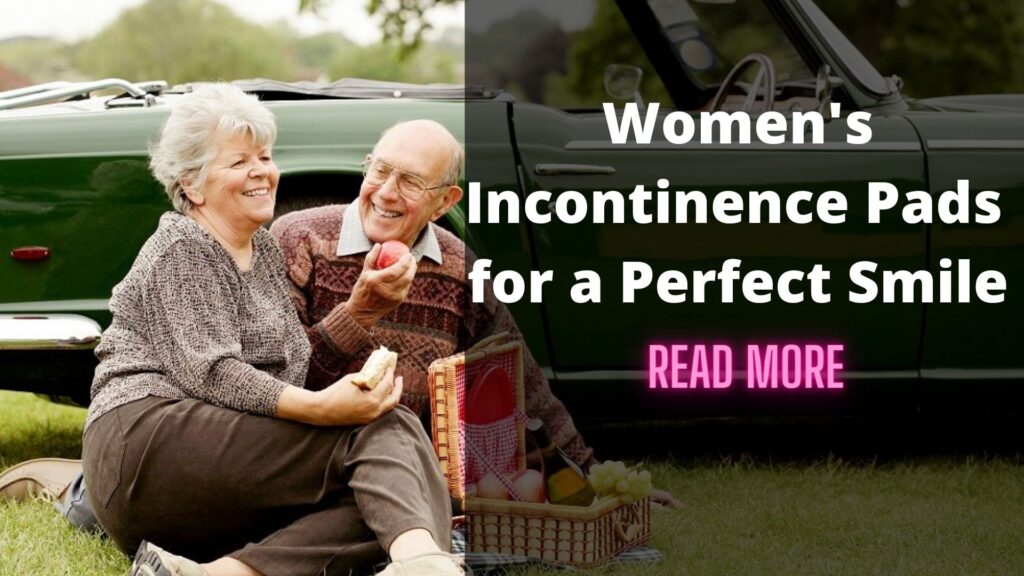Women’s Incontinence Pads – A Reason for A Smile
Women’s Incontinence Pad: The symptoms of uncontrollable urine loss (leakage) are urinary incontinence. It is a disease that affects both men and women, but it is more common in women. Incontinence in men has been related to various conditions, including prostate enlargement or damage to the continence system after prostate cancer surgery or radiation. On the other hand, incontinence in women is frequently connected to a malfunction of the pelvic floor or bladder muscles, with symptoms most commonly occurring during pregnancy, delivery or menopause.
Urinary incontinence has been divided into two categories by investigations throughout the years: urgency incontinence and stress incontinence. According to the International Urogynecological Association (IUGA) and the International Continence Society (ICS), the official definition of stress incontinence is the sensation of urine loss linked with sneezing or coughing and physical exertion. On the other hand, need incontinence is urine leakage accompanied by a strong urge to empty that is difficult to resist. These two forms of incontinence are so common that they coexist with various symptoms, a condition known as mixed incontinence. Most women with urgency incontinence have also been diagnosed with excessive bladder symptoms, with urgency incontinence being one of the possible components.
The Following Are the Different Types Of Urinary Incontinence:
- Urge incontinence: This is when you feel compelled to go to the bathroom right away. It happens too quickly for the person to get to a toilet in time, resulting in urine leakage. Urge incontinence is frequently caused by an overactive bladder condition (OAB). OAB can be caused by various factors, including weak pelvic muscles and nerves, nerve injury, infection, and low oestrogen levels after menopause or being overweight. Caffeine and alcohol, among other drinks and medicines, can cause OAB.
- Stress incontinence: Stress incontinence is defined as urine leakage while doing daily tasks. The pelvic floor muscles have grown weak and can no longer support the pelvic organs as they should in this type of incontinence. Because of this muscular weakness, the person is more prone to lose urine when moving about. When individuals laugh loudly, cough, sneeze, jump, run, or lift items, they often experience leakage. All of these activities press the bladder. If you don’t have strong pelvic muscles and a firm pelvic floor, you’re more prone to leak pee. Stress incontinence is more frequently observed in women who have recently given birth. Stress incontinence is a possibility for men who have had prostate surgery.
- Incontinence overflow: If a person’s bladder does not empty every time they go to the restroom, they may have overflow incontinence. Patients with overflow incontinence do not empty their bladders, bladder leakage pads, putting them in danger of spillage. Instead of a real splash out, this usually results in little volumes of pee spilling out over time (similar to a leaking balloon shrinking over time) (similar to pricking the balloon with a pin.)
- Mixed Incontinence: Mixed incontinence is the result of a combination of problems that produce leaking. If you have mixed incontinence, you may also have stress-related incontinence and an overactive bladder. When dealing with leakage difficulties due to mixed incontinence, it’s critical to watch what the individual is doing. The most efficient method to cope with mixed incontinence is to recognize the triggers.
The Symptoms and The Risk Factors Are As Follows:
To recognize that the reported symptoms typically correspond to the regular bladder functions and associated expectations, a thorough patient history should include the onset, duration, and frequency of urine incontinence, as well as the resulting LUTS and voiding symptoms. Age, obstetric history (parity and mode of delivery), gynaecological status (the presence of pelvic organ prolapse, defecatory dysfunction or anal incontinence, sexual dysfunction, and urogenital syndrome of menopause), medical status (the presence of a UTI, dementia, delirium, diabetes mellitus, and urogenital syndrome of menopause), and medical status (the presence of a UTI, dementia, delirium,
Urinary incontinence is 30% more prevalent in patients with mild cognitive deficits. In addition, lifestyle and functional characteristics such as smoking status, mobility, and the frequency of heavy lifting must be taken into account throughout the evaluation. Specific individuals may have a history of symptoms that point to other urinary tract diseases that might cause incontinence; however, these patients will need to be referred to a specialist.
Incontinence symptoms last a long time, have a significant influence on one’s quality of life and cost both people and society a lot of money. Incontinence of any type is more common as people gain weight and get older. As a result of current demographic trends, the health burden of these diseases is projected to increase. Compared to the public attention they receive or the level at which incontinence research is done, the impact on persons and groups afflicted by these diseases is significant.
WHAT ARE THE INCONTINENCE SIGNS?
Urinary leakage is the most common sign of urinary incontinence, which might be a steady stream of pee or a few isolated incidents. If a person has incontinence, there may be significant or minor quantities of urine flow. Leakage can occur for various causes, the most common of which is the kind of incontinence. Urine leaks can be caused by a variety of factors, including:
- Exercise.
- Cough.
- A wonderful time laughing.
- Sneeze.
WOMEN’S PRODUCTS:
- Pessaries: Disposable devices inserted into the vaginal canal to support the bladder and exert pressure on the urethra, preventing urine leaks. Pessaries are available in various sizes and forms, including rings, cubes, and plates.
- Urethral insert: This is a soft plastic balloon that is inserted into the urethra. It obstructs the flow of urine. In the event of voluntary urination, the insert must be removed. Some women use inserts just part of the time, such as while they exercise. Some people wear them all day. To prevent the transmission of germs, use a new sterile disposable insert each time.
- Disposable vaginal implant: This is a tampon-like device that is inserted into the vagina. To prevent urethral leaking, it exerts pressure on the urethra. It is available without a prescription at pharmacies.
What Are the Best Places To Buy Urinary Incontinence Pads?
The majority of items may be found in your neighbourhood pharmacy, supermarket, or medical supply shop. Before making a purchase, see a physician for a list of incontinence products to address incontinence.
INCONTINENCE PADS: WHAT TO LOOK FOR
- Absorbency: Depending on the severity of bladder issues, different briefs and pads absorb varying quantities of fluid. Consider using extra-absorbent briefs or pads if you can’t get to the bathroom on time, have more cravings, or have more leaks. They may be larger, but they allow the overall volume of leakage to be maintained.
- Daytime vs Nighttime Protection: Most individuals choose lightweight protection throughout the day and more absorbent options at night. Bed pads provide excellent overnight protection, allowing you to sleep soundly without worrying about your linens being ruined.
- Disposable vs Reusable: There are disposable diapers, pads, liners, and undergarments that can be washed and reused or recycled after one use. Disposable or washable bed pads are available; depending on the frequency of usage, the washable alternative may be preferred. If you’re looking for incontinence protection, think about how often you’ll need to use it and when you’ll need it the most.
In conclusion, consider the following aspects while selecting the finest incontinence pads:
- The amount of pee lost
- Comfort
- Cost
- Durability
- Simplicity
- Effectiveness in eliminating odours
- How frequently does one lose urine?
Women’s Incontinence Pads:
Urinary incontinence affects more than 200 million people throughout the world (UI). In Europe and North America, incontinence in the urinary tract is quite common, affecting 5-10% of the population. 10% to 30% of women under the age of 65 suffer from incontinence. The rate of incontinence in older women is significantly higher. 15% to 35% of women are not institutionalized, and more than half of those who are institutionalized or homebound are incontinent. Incontinence in the urinary system is a condition that affects more than 30% of older women in the United States.
According to a Brocklehurst study, 22% of women over 30 years old utilized incontinence pads when they first realized they had an incontinence problem. However, in the research of Herzog and Molander, significantly higher use of incontinence pads for women was discovered, with 55–68% of women over the age of 50 using incontinence pads for women. In separate research, Brink observed that 62 percent of women living in communities used incontinence pads. At the same time, McDowell discovered that 87% of cognitively healthy homebound women used incontinence pads before a behavioural intervention. Because of the widespread nature of the illness, primary care physicians are advised to detect and treat urine incontinence. Incontinence becomes more common as we get older, and it’s linked to a lower degree of happiness.
They are typically the first line of therapy for incontinence patients since they are readily accessible without a prescription. Many treatment alternatives exist, however not all offer long-term relief. Women’s absorbent incontinence pads, for example, are vital tools for UI. The amount of women who use pads varies throughout the literature. According to Iosif’s epidemiological study, just 28% of women who underwent hysterectomy used pads. They are typically the first line of therapy for incontinence patients since they are readily accessible without a prescription. Many treatment alternatives exist, however not all offer long-term relief. Women’s absorbent incontinence pads, for example, are vital treatment tools (UI). The amount of women who use pads varies throughout the literature. According to Iosif’s epidemiological study, just 28% of women who underwent hysterectomy used pads.
The direct cost of urinary incontinence in the United States of America is estimated to be billions of dollars each year, with three-quarters of that amount going toward treating women with the condition. In the United States of America, the yearly economic impact of urinary incontinence is estimated to be $11 billion. Costs associated with disposable diapers, wash pads, and in-dwelling catheters are included. In 1995, women suffering from detrusor instability spent an average of $135–138 per year on incontinence products. Women who suffer from stress incontinence were also charged $63.
Many instances of incontinence may be healed or eradicated by addressing the underlying reasons. Still, most patients will need to use incontinence pads for women or a device to control or prevent leaking. Incontinence pads must be replaced often due to their design and content. There are a variety of options; however disposable absorbent incontinence pads for women are the most popular. While there are several successful treatment options for incontinence in women, complete dryness is seldom attained. Women who suffer from urge incontinence may be significantly assisted by medical treatment, but they cannot be entirely healed by medical care or behavioural therapy.
Women with stress incontinence, on the other hand, are not surgical candidates. Even with the best therapy, some of them will always need incontinence products. They are available in various sizes, shapes, and designs, but all include a fluffed wood pulp absorbent core and a powdered hydrogel outer layer. If the pad is not designed with waterproof pants, it should have a water-permeable outer shell coverstock. They come in rolls and may be cut to length but are usually rectangular. Incontinence pads for women may be removed and reinserted without removing the pants if used with marsupial pants, including an outer pouch.
Incontinence is caused by a problem with the female urine storage or emptying system. Different individuals have urethral sphincter and bladder dysfunction, thus categorizing them may hinder their treatment. Detrusor contractions are easily controlled and do not cause incontinence. The overactive detrusor may induce incontinence in urethral sphincter injuries, especially after vaginal birth. Pregnancy may also harm a woman’s neuromuscular or anatomical structures. However, other components of the continence system may compensate for the illness. Incontinence may not occur until the urethral sphincter loses strength and innervation owing to ageing or other injuries. A slight loss may favour incontinence above the need for continence. Most incontinence information comes from people in the late stages of the illness (decompensated).
Stress-induced incontinence develops when the bladder pressure exceeds the urethral pressure occurs when intra-abdominal pressure abruptly increases. Changes in anatomy (lack of neck support for bladder backstops) or nerve-muscular injury may cause. Hypermobility is a term that refers to the absence of bladder neck support, and therapies attempt to stabilize and restore it. Traditional treatments seem to be unsuccessful for less severe types of stress incontinence. “Low urethral pressure” or “intrinsic sphincter failure” are terms used to characterize urethral muscle strength. Grouping patients, on the other hand, do not aid in diagnosis or therapy. Numerous studies indicate that the majority of people have both intrinsic sphincter dysfunction and bladder neck hypermobility.
Objectives:
An optimal incontinence pad must meet all of the following functional criteria, as outlined by A.M. Cottenden.
- Reliability: In terms of reliability, one may dependably collect pee at the flow rates and frequencies that have been set, as well as in the amounts that can be absorbed.
- High absorbent power: The urine stays in place without leaking until the pad is replaced due to high absorptive capacity.
- No skin rashes: This product has no side effects on the skin, including rashes.
- Comfort: In both wet and dry conditions, feel at ease.
- Density: Have a low density of mass
- Disposable: Make it simple to get rid of
- Accessibility: Be simple to put on and take off.
- Appearance: Have pleasant aesthetics and excellent visual appeal.
- Price: Be affordable in terms of pricing.
Unfortunately, fulfilling all functional needs is difficult due to the incompatibility of specific particular criteria; therefore, compromises must be made. Each individual requires a different level of compromise. For example, young women prefer smaller incontinence pads that are less prone to leak and conceal themselves under skinny pants or fashionable clothes. Older women would usually choose security by selecting an absorbent and possibly thicker product while losing subtlety.
Women’s incontinence pads lack the absorption capacity necessary to provide complete leakage prevention. Rather than that, the probability of leaking rises as the volume of pee increases. In contrast, the individual’s posture has a negligible effect on how much pee leaks from the pad. The ability of incontinence pads for women to absorb the material near to its core impacts the features of leakage. Features such as wing folding, form, and elastication all contribute to the reduction of leakage. For lighter wetters, pads designed with fast-strike-through coverstocks leak less. Pads’ comfort and dryness are determined by their breadth, length, and resistance to lateral compression. The use of coverstocks with rapid strike-through times may help alleviate the pain associated with damp pads. Coverstocks that are highly resistant to urine wetback are not more helpful to the skin than those less resistant.
Simple pants or incontinence pads are difficult to put on and take off. Regular or near-normal underwear pads that are not linked to baby diapers are also regarded as attractive. Pad selection, standardization, and product development have never been more critical. Increased use of incontinence products due to ageing population.
In managing UI, absorbent materials should not replace the evaluation and treatment plan procedure. Pads provide females with a sense of security and comfort, particularly in social situations. It is critical to educate physicians, gynaecologists, and female hygiene experts about the many kinds of pads, their prices, and their availability—less expensive menstrual products for UI women. Larger or more frequent UI may need more expensive incontinence treatments.
USAGE:
Female incontinence pads usage increases with age, according to Hogne Sandvik and Steinar Hunskaar’s research. A woman’s frequency rises about 20 years old, whereas a man’s rises. Continence pads for women do not show the often stated high incidence of UI among middle-aged women. It may be because midlife women have less severe incontinence symptoms.
Best Personal Pads:
Urine pads are intended to absorb more liquid than regular sanitary pads. They’re also waterproof. Women’s incontinence pads are worn inside undergarments. Disposable fabric pads and liners are available from certain businesses, along with waterproof trousers.
- Abena Abri-Form Premium Incontinence Briefs
Absorbency: 4
Absorbing Capacity: 4000ml absorbent capacity, six times the average bladder capacity of 400-600ml.
These briefs are four times more absorbent than other diapers available in shops, making them ideal for individuals with severe bladder problems and leaks. These briefs also include soft non-woven side panels that allow for effortless movement. The indication for moisture changes colour when the moment is perfect. The top layer of dry-acquire removes water instantly, keeping the skin dry and stress-free.
- Medline Heavy Absorbency Underpads
Largest size: 36 by 36 inches max.
These disposable pads have an ultra-absorbent core that protects against incontinence all day. These pads are soft and comfy, featuring a quilted top sheet for sensitive skin. The fluff and polymer also absorb odours and liquids. The mats have a polypropylene backing that holds them in place and prevents water spread.
- Intimates Overnight Pads: TENA
Tena pads are intended to protect against moderate to severe bladder leakage. They are 16 inches long and have a broad back for complete coverage while laying. They are tiny and light so that they won’t be visible. Super-absorbent beads suck in moisture while a soft, skin-friendly sheet keeps you cool.
- Reusable Bed Pads – Cardinal Health
These hospital-grade pads are ideal for those who leak a lot and wish to relax without worrying about ruining their bed. The waterproof pads keep the bed and other surfaces dry. The soft cushioned core absorbs and seals fluids. These pads are great for protecting sheets and bedding for men, women, children, and people with urinary problems.
The most important advantage is that the pads can be cleaned and reused. A non-slip base layer keeps the pad in place all night. It is latex and leads free. With polyester and composite fabric, it is safe for sensitive skin and pleasant sleep.
- Unisex Briefs
The briefs are ideal for severe bladder issues since they protect both day and night. With a strong leak barrier and adjustable tabs, they offer up to eight hours of odour prevention. They will keep the skin dry and pleasant with “SmartCool Breathability.” These briefs are thick and absorbent, but yet thin and discreet. The Dry-Lock Containment Core wicks away moisture, enabling one to return to family, friends, and daily life without worrying about leaks. For elderly or sensitive individuals, they are designed to be soft and pleasant.
- Poise
These odour-controlling pads help wick away water and absorb moisture for up to twelve hours, so you can sleep well knowing there will be no leaking.
Best Incontinence Pads for Heavy Leakage:

- What are large disposable pads?
They are also called form pads or two-piece sets. They are underwear. Companies that manufacture pads also make stretch pants. Regular underwear may also be worn if it is tight enough to hold the pad in place. To manage varying levels of leakage, most pads are designed to fit correctly and stay in place.
Its non-woven top layer allows urine to flow easily and keeps the skin dry. Its absorbent core is composed of fluffed fibrous wood pulp, typically combined with super-absorbent polymer powder, transforming into a gel and encapsulating urine. Many absorbent pads are waterproof. For excessive leakage, the finest incontinence pads include wetness indicators on the outer backing that indicate how much has been absorbed. You may prevent overfilling or spilling your pad on furniture or clothing by changing your pad regularly.
- What works for severe leaking incontinence pads?
Women with UI issues may use disposable pads to control incontinence. They are a cheaper option. Easy to swap out. Some women discover that the large disposable pads may leak more than other pad kinds. They enjoy disposable all-in-ones like belted pads, pull-on, or belted pads. Large pads lack absorption where pee flows typically, making them more prone to leaks late at night.
Brought To You By Incontinence Pads For Women
The post Women’s Incontinence Pads – A Reason for A Smile appeared first on EZi Reviews.
The Article Women’s Incontinence Pads – A Reason for A Smile First Appeared ON
: https://gqcentral.co.uk






Comments are closed